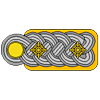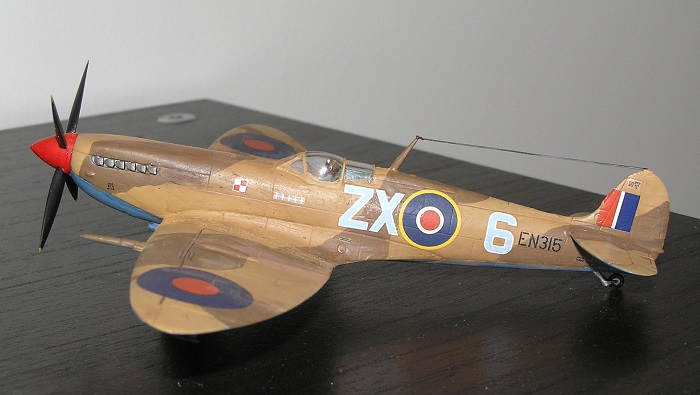I am returning to modeling after over 20 years away and I am having more fun than as a child, with the added advantages of better kits and better detailing possibilities.
As a child I was just happy to finish a model, now I am doing everything I can to make them look good with very mixed results.
So, with that in mind, when panting, in particular WWII multicolored cammo such as RAF aircraft, what would be a good way to mask to add 2nd and possibly 3rd colors?
What is a better way (if any) to set the line between the belly and the fuselage?
At the moment, I am not really concerned about getting the exact color, if asked for a specific RLM color, I find the closest thing I can get. Weathering will come when I figure out the best way to apply paint schemes.
Any advice on painting the smaller bits such as landing gear, cockpit and engines are also much needed.
Thanks
Orlando
Start Here (for Beginners)
This forum is for younger modelers or people just starting out in the hobby.
This forum is for younger modelers or people just starting out in the hobby.
Hosted by Jim Starkweather
Masking for painting questions and advice
opantoja

Joined: April 25, 2008
KitMaker: 22 posts
AeroScale: 19 posts

Posted: Tuesday, April 23, 2013 - 08:54 PM UTC
drabslab

Joined: September 28, 2004
KitMaker: 2,186 posts
AeroScale: 1,587 posts

Posted: Wednesday, April 24, 2013 - 02:04 AM UTC
There ae many threads on this site that may help you 
My few bits are:
This seems wrong, don't hurry and do everything as correct as you can that will give better results than trying to optimise one aspect of modelling and leave the rest to what it is.
Get an airbrush, results will be fenominally better than hand painted
I use tamiya tape, very good stuff


My few bits are:
Quoted Text
At the moment, I am not really concerned about getting the exact color
This seems wrong, don't hurry and do everything as correct as you can that will give better results than trying to optimise one aspect of modelling and leave the rest to what it is.
Quoted Text
the best way to apply paint schemes
Get an airbrush, results will be fenominally better than hand painted
Quoted Text
to set the line between the belly and the fuselage
I use tamiya tape, very good stuff

rochaped

Joined: August 27, 2010
KitMaker: 679 posts
AeroScale: 669 posts

Posted: Wednesday, April 24, 2013 - 04:32 AM UTC
Hi Orlando,
When dealing with multi-coloured camouflage make sure to start with the lighter colour then moving up in shades untill the final colour being the darkest of all.
To achive the necessary demarcation between colours i use tamiya tape or rolled wise blue tack (or similar brands). Both can be used to achieve straight lines or some more blended lines depending on lifting the edge a bit and the angle of the spray gun. Another simple way, if the camouflage line is made in straight lines is masking with post-it sheets. I use them quite often in splinter camouflage types.
As for cockpits & wheels best paint them separatly
Have fun, that's the point
Cheers
When dealing with multi-coloured camouflage make sure to start with the lighter colour then moving up in shades untill the final colour being the darkest of all.
To achive the necessary demarcation between colours i use tamiya tape or rolled wise blue tack (or similar brands). Both can be used to achieve straight lines or some more blended lines depending on lifting the edge a bit and the angle of the spray gun. Another simple way, if the camouflage line is made in straight lines is masking with post-it sheets. I use them quite often in splinter camouflage types.
As for cockpits & wheels best paint them separatly
Have fun, that's the point
Cheers
opantoja

Joined: April 25, 2008
KitMaker: 22 posts
AeroScale: 19 posts

Posted: Wednesday, April 24, 2013 - 05:04 AM UTC
Thanks for the input, so far it has been pretty good, I´ll try the rolled blue tak, it sounds pretty simple.
I would like to clear up the exact color thing, in some cases, the differences between say RLM 70, 71 and 73 are so tiny, you would have to be an expert to tell the differences in other cases the difference between Italian Olive Green and Dark Dark green is in the eye of the beholder.
In the case of Italeri´s 1/72 SM 82 in 1944 Italian Air Force colors, The call out asks for Italian Olive Green Model Masters 4734, I have Tamiya XF44 Dark Green problem solved.
I would have to mail order any additional colors I don't have, I live in a small town in southern Spain with very limited resources and the only hobby shop is an RC shop about 16 miles away and they do not carry much in the way of modelling other than figures and armor in small scales. I do what I can with what I have.
I wish I had a Hannants or a Squadron shop near me...what dream come true!
I would like to clear up the exact color thing, in some cases, the differences between say RLM 70, 71 and 73 are so tiny, you would have to be an expert to tell the differences in other cases the difference between Italian Olive Green and Dark Dark green is in the eye of the beholder.
In the case of Italeri´s 1/72 SM 82 in 1944 Italian Air Force colors, The call out asks for Italian Olive Green Model Masters 4734, I have Tamiya XF44 Dark Green problem solved.
I would have to mail order any additional colors I don't have, I live in a small town in southern Spain with very limited resources and the only hobby shop is an RC shop about 16 miles away and they do not carry much in the way of modelling other than figures and armor in small scales. I do what I can with what I have.
I wish I had a Hannants or a Squadron shop near me...what dream come true!
golfermd

Joined: March 01, 2013
KitMaker: 152 posts
AeroScale: 98 posts

Posted: Wednesday, April 24, 2013 - 07:18 AM UTC
I found that Tamiya masking tape work great for me. Gives me the least amount of damage. And, yes, and airbrush will make the paint job so much nicer. I have found that I generally spend 3 times longer masking than I do painting. But the results are well worth the time and effort. 

Posted: Wednesday, April 24, 2013 - 07:12 PM UTC
Hi Orlando,
Tamiya Kubaki masking tape is the best around, but fairly expensive, I have found Tetra (online) and Frog at DIY outlets, they are both similar to Tamiya and also relatively expensive, but you get far more on a roll so the cost is minimised
A few tips when using masking tape:
1. Always use a cut edge(unless you have a closed dispenser, that you can buy for Tamiya tape. But I still cut the edge)To cut, lay a length of tape on a cutting mat and use a steel ruler and a sharp blade. The edge of a roll of masking tape will, always, have dust and other particles sticking to it, even if you can't see them.
2. For masking over compound curves, or any curve for that matter, cut the tape into thin strips of about 2-3mm, the more complex or tight the curve the thinner the tape should be. You can buy very thin masking tape but it's not generally necessary unless you require tape with parallel sides [but see below].
3. When you cut tape into thin strips don't worry if the edges aren't parallel as you will only need the one straight edge.
4. If you do want to have the 2 sides parallel tape, or glue, 2 pointy blades side by side, the ground angle will give you separation, if you want a wider cut place a spacer between the blades (they need to be accurately aligned). Caution; you only get one go at cutting through the tape as any subsequent passes will invariably not be on the same cut lines!
5. Take your time when laying the tape down, use the Mk 1 eyeball to check the accuracy of the position. The Mk 1 eyeball is surprisingly accurate
6. For straight edge masking, such as Luftwaffe camo, use Tamiya tape for the masked edges and fill in with some cheaper masking tape. Make sure that it is low tack and don't leave it on too long.
7. for the likes of RAF camo use either paper templates or the blue tack worm method. If you use paper tmplates cut holes along the centre of each mask and you can tape the templates down through them. Blue tack is actually difficult to get a convincing pattern, because most simply roll the worms between their hands. This gives you undulating lengths. So, roll the blue tack between 2 boards to get an even thickness. The tighter the turns that you need to make the thinner the worms need to be. Fill in between the worms with the cheaper masking tape.
8. As an alternative to the above, if you want camo mask, for a Spitfire, ask me and I will send you a set of my masks for just the postage
I hope that helps?
Tamiya Kubaki masking tape is the best around, but fairly expensive, I have found Tetra (online) and Frog at DIY outlets, they are both similar to Tamiya and also relatively expensive, but you get far more on a roll so the cost is minimised

A few tips when using masking tape:
1. Always use a cut edge(unless you have a closed dispenser, that you can buy for Tamiya tape. But I still cut the edge)To cut, lay a length of tape on a cutting mat and use a steel ruler and a sharp blade. The edge of a roll of masking tape will, always, have dust and other particles sticking to it, even if you can't see them.
2. For masking over compound curves, or any curve for that matter, cut the tape into thin strips of about 2-3mm, the more complex or tight the curve the thinner the tape should be. You can buy very thin masking tape but it's not generally necessary unless you require tape with parallel sides [but see below].
3. When you cut tape into thin strips don't worry if the edges aren't parallel as you will only need the one straight edge.
4. If you do want to have the 2 sides parallel tape, or glue, 2 pointy blades side by side, the ground angle will give you separation, if you want a wider cut place a spacer between the blades (they need to be accurately aligned). Caution; you only get one go at cutting through the tape as any subsequent passes will invariably not be on the same cut lines!
5. Take your time when laying the tape down, use the Mk 1 eyeball to check the accuracy of the position. The Mk 1 eyeball is surprisingly accurate

6. For straight edge masking, such as Luftwaffe camo, use Tamiya tape for the masked edges and fill in with some cheaper masking tape. Make sure that it is low tack and don't leave it on too long.
7. for the likes of RAF camo use either paper templates or the blue tack worm method. If you use paper tmplates cut holes along the centre of each mask and you can tape the templates down through them. Blue tack is actually difficult to get a convincing pattern, because most simply roll the worms between their hands. This gives you undulating lengths. So, roll the blue tack between 2 boards to get an even thickness. The tighter the turns that you need to make the thinner the worms need to be. Fill in between the worms with the cheaper masking tape.
8. As an alternative to the above, if you want camo mask, for a Spitfire, ask me and I will send you a set of my masks for just the postage

I hope that helps?
J8kob_F

Joined: October 24, 2012
KitMaker: 202 posts
AeroScale: 92 posts

Posted: Wednesday, April 24, 2013 - 10:44 PM UTC
Quoted Text
A few tips when using masking tape:
1. Always use a cut edge(unless you have a closed dispenser, that you can buy for Tamiya tape. But I still cut the edge)To cut, lay a length of tape on a cutting mat and use a steel ruler and a sharp blade. The edge of a roll of masking tape will, always, have dust and other particles sticking to it, even if you can't see them.
Heureka! I've always had the problem with dust collecting at the edges never thought of cutting the edge of thus removing the dust. Thanks man!!
Jakob
Posted: Thursday, April 25, 2013 - 05:48 PM UTC
That's why they call me Mal the mask (well one of the reasons  )
)
Glad to be of help
 )
)Glad to be of help


SuperSandaas

Joined: October 23, 2012
KitMaker: 189 posts
AeroScale: 142 posts

Posted: Monday, June 03, 2013 - 11:39 AM UTC
Personally I just use brush-painting, since I can't really defend spending money on an airbrush (yet). I use several differnt brands, but lately I've used more and more Agama since I can order it cheaply from the Czech republic, and they have a wide range of colors. They usually need 3 or 4 thin layers though.
For straight lines I use basic masking-tape which I stick to the worktable a few times to make a bit less sticky.
Example: 1:72 Bf109E

For more flowing camouflage I just paint freehand. The important part here is to paint dark on light for the best result. Example: 1:72 Spitfire

For straight lines I use basic masking-tape which I stick to the worktable a few times to make a bit less sticky.
Example: 1:72 Bf109E

For more flowing camouflage I just paint freehand. The important part here is to paint dark on light for the best result. Example: 1:72 Spitfire

 |












